Thunderstorm of the twelfth year. Shotguns
Arrived - who helped us here?
Frenzy of the people
Barclay, winter or Russian god?
A. S. Pushkin. Eugene Onegin
Attention of all, I ask, gentlemen.
Trouble has come to the Motherland.
A war thunderstorm covered our sky.
On the twelfth day the Neman was crossed
Suddenly Bonaparte's troops ...
Hussar ballad. 1962 g.
Weapon 1812 year. What could be more formidable than a man-made weapon? Well, except that the phenomena of nature. But at the beginning of the 1812th century, man was not yet strong enough to release a force comparable to the forces of nature by pressing one or more multi-colored buttons. But even primitive rifles and bayonets, cannons and cannonballs, sabers and broadswords of that time brought death to people very effectively. For example, in the Paris Army Museum there is a metal cuirassier of a French cuirassier, on the left side of which there is a gaping hole with ragged edges, the size of a fist, made by a cannonball. And one can imagine what was the fate of this rider after that. Sometimes a rifle bullet (the size of a walnut) was quite enough to pierce it in the same way. And now, having read about this in one of the previous materials, some readers of "VO" asked me to tell in more detail about the weapons of 1812, both ours and our opponents. And now our story will go about him, accompanied by drawings by our famous illustrator A. Sheps. As for the illustrations with samples of the uniform of the Russian army in 1911, they belong to a series of drawings by N.V. Zaretsky, prepared by him in 1812 for the anniversary of the Patriotic War of XNUMX, on the basis of which a series of popular postcards was issued.
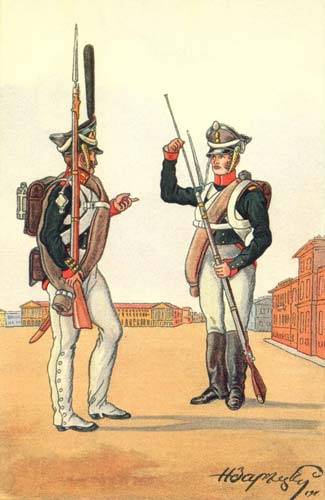
The main force of the Russian imperial army, however, and not only the Russian one, in the Patriotic War of 1812 was the infantry, the number of which was almost two-thirds of its personnel. The infantry regiment numbered 2201 privates and officers, 1800 of whom had an infantry rifle as their main weapon. Why is it important to emphasize? Simply because at that time there was a rather strange practice: each branch of the army has its own, different from all other guns. But at the same time, it was the infantry rifle with a bayonet that was the main weapon in the army. It weighed more than five kilograms, but it was very durable. So, in 1808, the commander of the Libau musketeer regiment reported that his regiment used rifles as early as 1700, that is, peers of Peter the Great and the Battle of Poltava. This happened because weapons were made in that era with a very large margin of safety, they were fired from these guns quite rarely, and they were looked after with great care. So it turned out that they served for a century and more! Among the infantry rifles there were many captured samples. For example, French, purchased by Russia in England, as well as Austrian, Prussian, Dutch, and also Swedish. But it was good that they practically did not differ from each other by their device. They all had a French battery lock, but differed only in small details.
The other was bad: all these weapons had barrels with different bore diameters, so that in the Russian army in 1808-1809 there were simultaneously weapons of 28 different calibers, from 13,7 to 22 mm. Centrally supplying them with ammunition was extremely difficult. But a solution was found: the soldiers themselves cast the bullets (for this, special bullets were supplied to the regiments), and paper cartridges were glued - for this, cartridge holders were also needed, so the main thing the quartermasters had to take care of was gunpowder.
In 1805, a truly revolutionary decision was finally made: to establish in the army a single caliber for both rifles and pistols, equal to 7 lines, or 17,78 mm, and at once solve the supply problem. New guns from the same year began to be supplied to the army, although old samples were also used. However, by the standards of our days, this caliber was very large, surpassing the anti-tank guns of the period of the Great Patriotic War. The bullet looked like a ball cast from lead and weighed 27,7 g, and the charge of gunpowder for an infantry rifle was 8,6 g.
However, deciding is one thing, but organizing the production of new weapons is quite another, and it is even more difficult to saturate your army with these weapons. The equipment of the then Russian arms factories was extremely primitive, there were practically no machines at all, all the work was done either by hand, or, at best, by the force of ... falling water! In the dry season, such a drive, of course, did not work! And on the eve of the war with Napoleon in 1805, he again had to turn to England and buy 60 thousand guns there. Defeat at Austerlitz? Orders again, because a lot of weapons were lost. It would be a sin to speak, but the Tula Arms Factory tried. I tried very hard, before I produced no more than 40 thousand guns a year, but in the same 1808 I was able to increase their output by half! And before the war of 1812, the production of guns and pistols on it was brought to 100 thousand units per year. But as the army lacked small arms, it continued to be in short supply. And again, 24 thousand guns were imported from Austria and another 30 thousand, the very next year, from England. And in total, England supplied Russia in those years more than 100 thousand guns of English production, that is, almost the same as our Tula arms factory produced in the same year! These are the needs of the army for guns and how they were met in those years.
And now let's add a few more words about one very interesting feature that distinguished the armament of the army of that time from the army of today. Now everyone is striving for the unification of weapons of different types of troops, but at that time it was considered simply necessary for each type of troops to have their own completely special and different weapons. So, in addition to the infantry rifle, there was a dragoon rifle, less weight and length, which had the same caliber, but a smaller charge of gunpowder in the cartridge. A cuirassier rifle - like a dragoon's, but only without a bayonet, and on the left side it had a metal shoulder strap (rod) with a belt ring on its stock, since cuirassiers carried guns on the right at the belt. There was also a special hussar gun - even lighter, shorter and, accordingly, designed for a smaller powder charge.
The guns were arranged simply. The barrel is iron, smooth inside, cone-shaped outside. The tail part of the trunk is faceted and had five edges. On the thread, a breech was screwed into it, which fastened the barrel to the stock with a screw. And he also greatly facilitated the care of the gun barrel, since by unscrewing it, it was easy to clean the channel on both sides. A hole was drilled on the right side face of the barrel, through which from the shelf of the castle the flame from the blazing gunpowder fell into the barrel and set fire to the powder charge. It is clear that the gun would not be a gun if it did not have a lock, in this case a flintlock. The standard lock consisted of 13 parts. It was arranged in such a way that, when released, the trigger with a flint clamped in it would strike a sheaf of sparks that set fire to gunpowder on the shelf. Both the trunk and the lock were fastened in a birch-tree stock, which was one piece with the butt. On the left side, the butt had a recess for the shooter's cheek - so that he did not touch the butt with it and could not receive a blow during recoil. Small parts, which served to fasten the barrel to the stock and protect it from damage ("box device"), were made of yellow copper.
* Fusilier (fr.) - shooter.
** Chasseur (fr.) - huntsman.
*** Voltigeur (French) - infantryman-shooter
The barrel and the stock covered three false rings, while the front sight was soldered to the uppermost ring (or the front one), and not to the barrel. The bayonet was necessary for hand-to-hand combat, was three-edged in shape, piercing and had a mass of 320 g. A leather strap passed through the swivels (arcuate devices in front of the trigger guard and on the middle stock ring) was required to carry the gun. To load flintlock weapons, a ramrod was required. At one end, on the ramrod of a Russian infantry rifle, there was a head for adjusting the bullet to the charge; on the other one could screw a pyzhovnik, something like a corkscrew, with which a bullet was removed from the barrel in case of a misfire.
It was noted that the guns of the Tula plant were somewhat inferior in quality to the English guns, but they were no worse than the Austrian and French guns, which was proved in comparative tests of domestic, French and English guns back in 1808. Then this was confirmed during the battles of the Patriotic War of 1812.
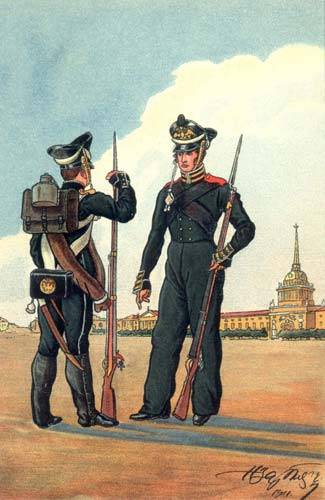
Why it was so, however, is understandable. The latest French gun at the time, AN-IX (the last two digits are the date of adoption according to the revolutionary calendar adopted in France) of the 1801 model practically did not differ from the 1777 gun, and the Austrian gun of 1807 - from the 1798 model. The British used the "Brown Bess" flintlock musket, which had a caliber of 0,75 inches (19,05 mm) from 1720 to 1840, and this model also remained practically unchanged over the entire period.
With the unification of weapons in France, things were also not the best way. There, along with the "relatives" were used Austrian, Russian (!), English, Dutch and God knows what other guns. Napoleon's Great Army required a lot of firearms, but where could they get them? The production capacity of the French arsenals was much inferior to the production capacity of British enterprises, moreover, they were already equipped with new steam-driven machines.
The rifles of the infantry rangers, who operated in loose formation and at the same time could shoot quickly and also accurately, were different from the infantry. They were lighter and shorter, which made them easier to handle, and therefore the rate of fire of their guns was higher than that of the line infantry guns. Although they were also more expensive, primarily due to a better finish on the barrel. Rangers had to load them not only while standing, but also lying down (they were allowed to apply to the terrain!), Since the barrel length of their guns was shorter. By the way, this also helped rapid-fire: the powder charge in such a barrel could be quickly promoted to the treasury, and, therefore, a new shot could be fired.
However, the main means of enhancing the firepower of the rangers were rifled fittings, which were used to arm non-commissioned officers and the most well-aimed shooters. In the Russian imperial army, these were fittings of the 1805 model, which had a caliber of 16,51 mm and eight rifling in the barrel. The regiment had only 120 of these guns. But the range of the shot was more than a thousand steps, and their accuracy was much higher than that of smooth-bore rifles. The fittings also had the first, special sighting devices in the form of two shields with slots. With their help, the front sight was sighted, combined with the target. A wooden mallet was also relied on the fittings - to hammer a bullet into the barrel. So they reluctantly "hit rarely, but aptly." However, the jaegers also had to go into bayonet attacks, therefore, bayonets in the form of ... a dagger weighing 710 g were attached to their fittings. So, together with the bayonet, the total mass of the jaeger fitting was quite large - 4,99 kg. The cavalry fitting of 1803 was very short and did not receive much distribution. The infantry did not have a bayonet to him, and the cavalrymen had no time to tinker with the tight drive of the bullet into the barrel.
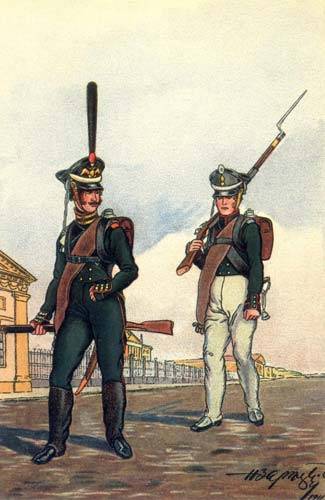
In the wars with Napoleon, including the war of 1812, the Russian cavalry, divided into regular and irregular, also played an important role. The regular cavalry consisted of guards, cuirassiers, dragoons, hussars and lancers regiments. Well, the irregular is, of course, the Cossacks, of whom there were even more in the army than all the other cavalrymen: over 100 horsemen!
Cavalry firearms, in principle, did not differ from infantry ones, but they had some features that were associated with their use by riders, and besides, they were somewhat more diverse. For example, both heavy and light cavalry had rifles, carbines, blunderbuss (they were not used at all in the infantry!), Fittings and pistols.
Cuirassiers and dragoons had shotguns of the 1809 model and two pistols of the same year in saddle holsters. Sixteen people in each squadron had fittings that were very similar to the jaeger, but even shorter. A similar number of fittings were in the Uhlan regiments. The soldier with fittings was called carabinieri. At the same time, in the hussar regiments, instead of fittings, a hussar carbine of the 1809 model and the most ominous type of blunderbuss were adopted: a short gun with a bell at the end of the barrel, firing a large buckshot at a close distance. By the way, it was the hussar small arms that were then the shortest of all the other models. The barrel of the carbine was only 637,5 mm long, while the length of the infantry rifle was 1141 mm, and that of the dragoon rifle was 928 mm. The blunderbuss barrel was even shorter - only 447 mm. Lancers and hussars also had two holsters with pistols, left and right at the saddle. But we will talk about pistols of 1812, as well as about melee weapons next time.
To be continued ...
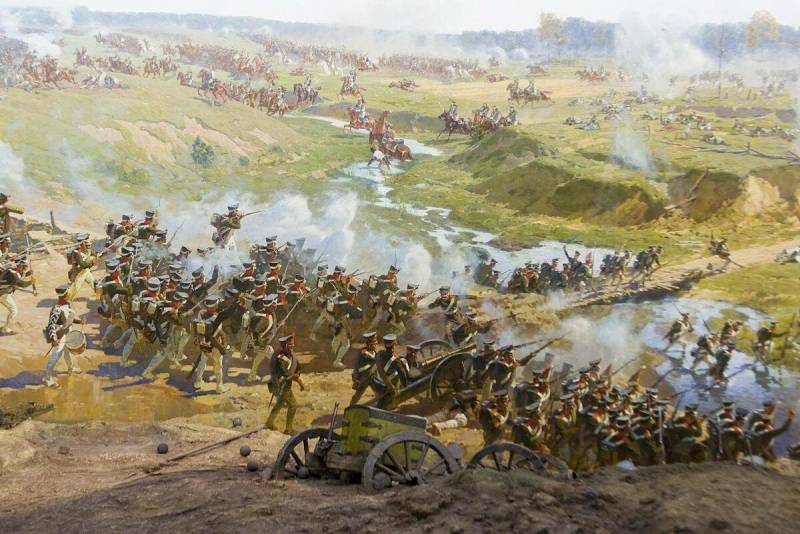




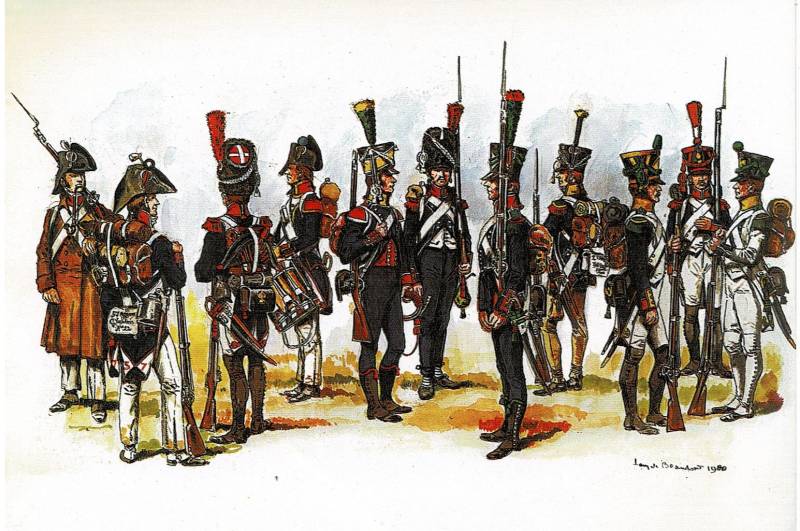




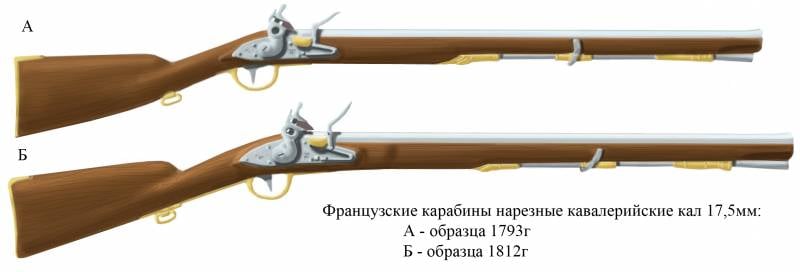


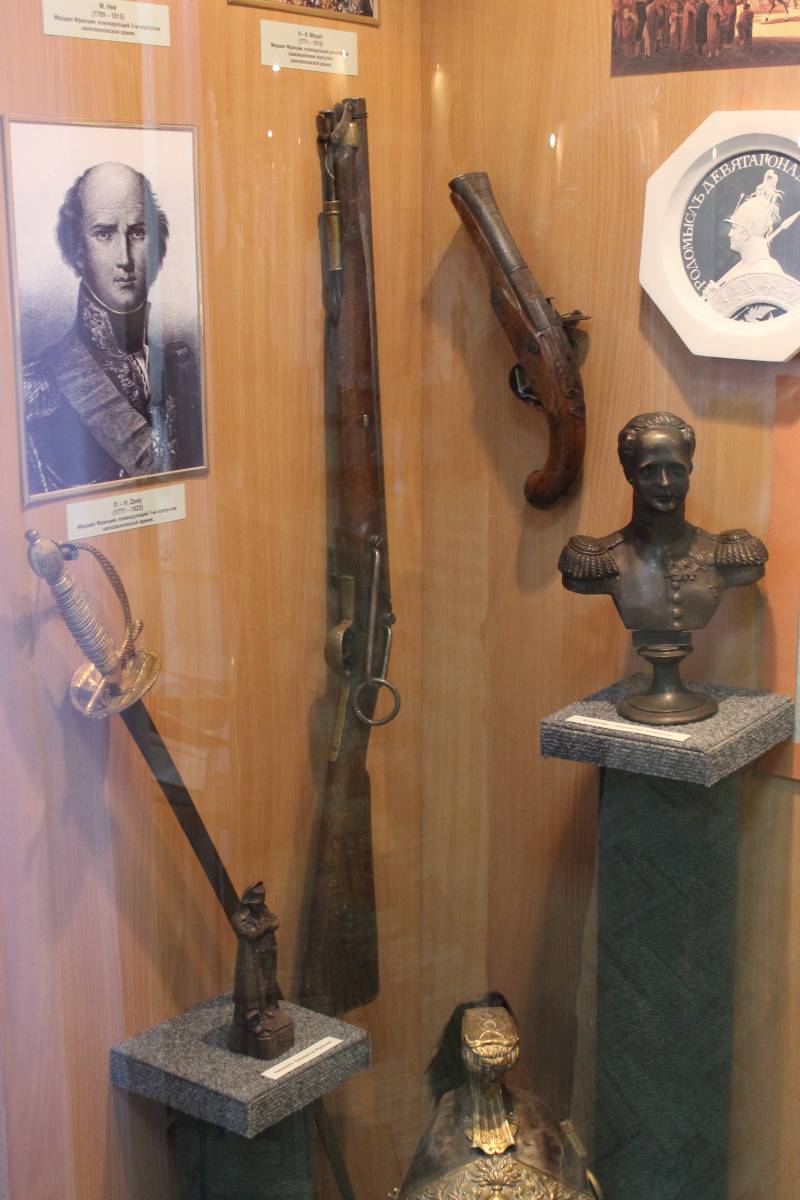
Information